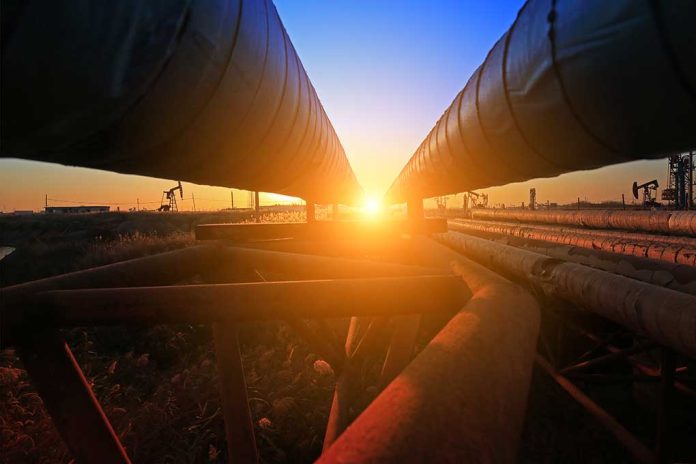
Keystone Pipeline operations came to an abrupt halt after a mysterious “bang” led to a rupture and oil spill in North Dakota, once again raising questions about the controversial pipeline’s safety record and the Biden administration’s energy policies.
Key Takeaways
- The Keystone Pipeline ruptured near Fort Ransom, North Dakota, after an employee at a pump station heard a “mechanical bang,” prompting an immediate shutdown.
- Oil was released into an agricultural field, though officials report no impacts to people, structures, or nearby waterways.
- This marks at least the fourth significant spill for the pipeline since 2017, raising further concerns about its reliability and environmental impact.
- The pipeline normally transports 624,000 barrels of Canadian crude oil daily to U.S. refineries, highlighting its importance to North American energy infrastructure.
- The incident has rekindled debate about the canceled Keystone XL expansion, which would have created thousands of jobs and billions in economic impact before President Biden terminated the project in 2021.
Sudden Rupture Forces Emergency Shutdown
The Keystone Pipeline was shut down following a rupture near Fort Ransom, North Dakota. According to Bill Suess, spill investigation program manager with the North Dakota Department of Environmental Quality, “The Keystone Pipeline was shut down after a ‘bang’ was reported in North Dakota,” reported Suess. The incident occurred at milepost 171 when an employee at a pump station heard what was described as a “mechanical bang,” immediately triggering emergency protocols.
South Bow, the company that has managed the pipeline since early 2024, detected a sudden pressure drop in their control center. Following established safety procedures, they promptly initiated a complete shutdown of pipeline operations and dispatched response teams to the site. The company stated they made “appropriate notifications to our regulators, landowners and customers.”
BREAKING NEWS:
The Keystone Pipeline has RUPTURED.
Oil spill near Edinburgh, North Dakota after rupture of Keystone pipeline. pic.twitter.com/ScJbcKc98b
— Mila Joy (@MilaLovesJoe) April 9, 2025
The rupture resulted in crude oil being released into an agricultural field south of the pump station. While the exact amount of oil spilled remains under investigation, officials have indicated the spill appears to be contained. The North Dakota Department of Environmental Quality is currently overseeing cleanup and remediation efforts. Fortunately, no people or structures were affected, and a nearby stream showed no signs of contamination.
Troubled History and Economic Significance
This rupture adds to the Keystone Pipeline’s troubled history. The pipeline has experienced at least three significant spills since 2017, including its largest in 2022 in Kansas. The pipeline, operational since 2010 at a cost of $5.2 billion, plays a crucial role in transporting Canadian crude oil to U.S. refineries. Prior to the shutdown, it was carrying an average of 624,000 barrels of oil per day, representing a significant portion of cross-border energy exchange.
The pipeline’s strategic importance stretches beyond its daily oil delivery. It serves as a vital link in North America’s energy infrastructure, connecting Canadian oil fields to refineries in Illinois and Oklahoma. The recurring spills, however, have fueled criticism from environmental groups who point to these incidents as evidence supporting their opposition to pipeline expansion projects, particularly the canceled Keystone XL extension.
Keystone XL: The Abandoned Opportunity
The shutdown has reignited debate about the controversial Keystone XL extension, which President Biden canceled in 2021 shortly after taking office. The expansion would have significantly increased capacity, carrying up to 830,000 barrels of crude oil daily. According to economic analyses conducted in 2014, the project was projected to support approximately 42,100 jobs and contribute $3.4 billion to the U.S. GDP during construction.
Beyond the temporary construction jobs, the XL extension was expected to generate $55.6 million in annual property tax revenue for communities across Montana, South Dakota, and Nebraska. The cancellation drew sharp criticism from Canadian officials and energy sector advocates who viewed the decision as detrimental to North American energy security and economic development. President Donald Trump has repeatedly called for the project’s completion, highlighting it as an example of energy policies that prioritize domestic production.
As cleanup efforts continue in North Dakota, the incident serves as a reminder of the complex tradeoffs between energy security, economic benefits, environmental concerns, and infrastructure reliability that continue to shape America’s energy policy debates. South Bow has not yet provided a timeline for when the pipeline might resume operations, leaving the transportation of hundreds of thousands of barrels of Canadian crude temporarily disrupted.
Sources:
Keystone oil pipeline shut down after “mechanical bang” reported
Keystone pipeline shut down after rupture
Keystone pipeline shut down after rupture, oil spill contained



